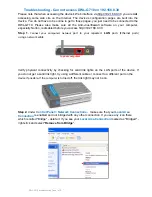
Page 9
4. Trouble Shooting
This troubleshooting section is intended to help you solve the most common problems on
the VOL-1081 Fiber Switch. The Switch can be easily monitored through panel indicators
to assist in identifying problems. This section describes common problems you may
encounter and where you can find possible solutions.
Diagnosing with the LED Indicators
Link
If the Lnk / Act indicator does not light up after making a connection check whether the
network interface (e.g., a network adapter card on the attached device), network cable,
or switch port is defective. Verify that the switch and attached device are on. Be sure the
cable is plugged in at both ends. Verify that the proper cable type is used and its length
does not exceed specified limits.
Power
If the Pwr indicator does turn on when the power cord is plugged in, you may have a
problem with power outlet, or power cord. However, if the Switch powers off after
running for a while check for loose power connections, power losses or surges at power
outlet.
Transmission Mode
The VOL-1081 RJ-45 ports use auto-negotiation to set the transmission mode (i.e., half
or full duplex). Verify that each attached device is configured to use auto-negotiation to
set the transmission mode. If auto-negotiation fails the switch will default to half duplex.
This means no connection will occur if the device attached to the RJ-45 port is set to full
duplex mode.
The fiber port requires a manual setting of the transmission mode by means of the DIP
switch. This means the device attached to the fiber port must be similarly configured
(i.e., half or full duplex). Remember to cycle the power on the VOL-1081 after the DIP
switch is changed.
Cabling
ÿ
RJ-45 ports: Use unshielded twisted-pair (UTP) or shield twisted-pair (STP) cable for
RJ-45 connections: 100
Category 3, 4 or 5 cable for 10Mbps connections or 100
Category 5 cable for 100Mbps connections. Also be sure that the length of any twisted-
pair connection does not exceed 100 meters (328 feet).
ÿ
100Base-FX fiber port: Fiber port can use 50, or 62.5um multi-mode fiber cable to
connect devices over a 2-kilometer distance.






























